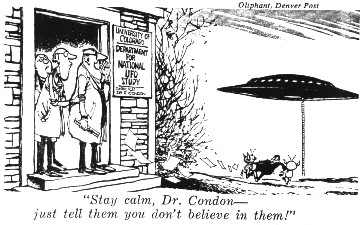|
Scientific Research, April 14, 1969, p. 41.
Scientific Study of Unidentified Flying Objects conducted by
the University of Colorado, edited by Daniel S. Gillmor (Bantam Books,
New York, 1969, $1.95 paperback, 965 pp.)
Reviewed by Robert M. L. Baker Jr.
This half-million-dollar, 965-page report probably represents the ultimate
case against the UFO "cult" – in fact, it was to be the last scientific
word on that controversial subject. But, paradoxically, the report contains
some evidence suggesting that the UFO phenomenon should be studied further.
It is an unfortunate feature of the report that the most provocative and unexplained UFO sightings are virtually hidden between extensive discussions of explained cases and often superfluous technical background material. For example, it is not until page 164 that the first detailed study of a truly interesting, unexplained sighting appears. In fact, the very intriguing sightings made by several astronauts are buried behind 85 percent of this section, most of which is concerned with irrelevant details of astronautics. Scientific reports are seldom burdened with detailed studies of those blind alleys that produced little or no useful data-yet the Cordon report shuffles explained and unexplained cases at random, in what seems to be an almost contrived manner-and this tactic confuses or diverts all but the most dedicated reader. If after a preliminary investigation it appeared that some UFO observations could not be easily explained, they should nevertheless have been highlighted in some way Then the explained cases should have been appended in order to show how an unexplained case might be rationalized through its similarity to one that is already understood. The real crux of the matter, finally, would be the analysis of W. K. Hartmann, who discusses the question "Are misinterpretation and mis-reporting sufficiently common as to make credible the assertion that the entire UFO phenomenon, or at least the residua of unidentified cases, is the result of these processes (plus deliberate hoaxes)?" But where is Hartmann's crucial question finally treated? It is practically lost in mid-volume - on pages 567 to 590. A critical conclusion is made there: that the truly unexplained sightings total less than 2 percent of all UFO sightings. This, at least, is a factual basis for many of Condon's preliminary remarks. But Hartmann's analyses should have been expanded within the context of unexplained sightings - not in the context of explained cases. Furthermore, there is presumably somewhere in this study a detailed quantitative verification of Condon's contention that "... no intelligent life elsewhere outside of our solar systems has any possibility of visiting earth in the next 10,000 years." But so far I have been unable to find any comprehensive analysis to support that figure. It should have been recognized that the 10,000-year quarantine on the earth and Hartmann's statistics are both vital aspects of this study as long as there are still unexplained UFO sightings. One can appreciate R. V. Jones's remark (page 932) that "they [UFOs] were either a fantasy or an incorrect identification or a rare and unrecognized phenomenon and while I commend any genuine search for new phenomena, little short of a tangible relic would dispel my skepticism of flying saucers." However, the counter-argument is that an incorrect identification of a rare and unrecognized phenomenon may be the clue to the discovery of a new phenomenon. These "new phenomena" need not necessarily be classified as flying saucers transporting intelligent extraterrestrial life; they could be some new form of atmospheric plasma, entering comets, or similar oddities.
Indeed, it would seem to be of basic scientific value to determine if there were a reasonably high probability that some new phenomena are at work in the unexplained UFO observations. The next logical step would be to see if a consistent pattern to these observations exists, and then to provide a set of hypotheses that might explain them. Of course, the Condon group was not expected to provide such hypotheses - but in view of its claim of insufficient data it might have suggested new data-collection techniques for closing this data gap. In sum, the veracity of most of the study seems to be beyond question- the Condon group has gathered and analyzed a significant subset of the significant facts bearing on the UFO question. Moreover, the group has presented important (although hard to find) evidence that seems to justify scientific investigation along many general and specialized frontiers. Therefore, it is not the facts that are subject to criticism, but rather their organization and interpretation.
Robert M. L. Baker Jr., 38, teaches
at the Univ. of California at Los Angeles and is a senior scientist at
Computer Sciences Corp. His specialty is aerospace dynamics.
|
